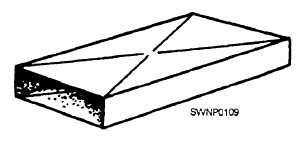fittings needed in a complete heating, ventilating, and air-conditioning system. The Steelworker must be very versatile because the most difficult part of sheet-metal work is the installation of a product that has been built in a shop and is installed on a site at a later time.
All of the variables and problems that occur during the installation process cannot be covered here; however, this section will cover some of the different hanging and connecting systems used by the sheet-metal worker. The type of connecting system used depends upon where the duct system is installed, its size, how many obstructions there are, and also, what type of structure the system is hanging from or connected to.
SHOP PROCEDURES
The small sheet metal shops in the NCF or in a Public Works Department are normally tasked with single fabrication jobs for an NCF project or small repair projects. These shops usually employ a small number of Steelworkers as part of a multi-shop environment. The senior Steelworker assigned to a shop is tasked with the plan development and estimating of materials. The layout Steelworker makes up most of the fittings in the shop and is responsible for stockpiling patterns and tracings on standard fittings used for sheet-metal duct systems.
NOTE:
You should fabricate an entire job at the shop, rather than deliver an incomplete system to the jobsite.
SHOP DRAWINGS
A shop drawing is a plan view or an elevation view of a fitting, duct, or other object that is drawn either by the freehand sketch method or by using drafting instruments. It maybe useful to get assistance from an Engineering Aid for complex duct systems or fittings. One of the better methods is to draw a complete set of standard fittings and then add the required dimensions to fit the job.
The dimensions shown on the views of a shop drawing are finished dimensions. Once the finished dimensions have been determined, one-half inch must be added to each end to obtain the raw size of the pattern. This dimension produces a cut size dimension. The type of material, gauge number, and type of seam may be added to the shop drawing if desired. Usually these are specified on the drawings and on the pattern sheets.
DUCT MATERIAL
Metal sheets, wire, band iron, and angle iron are the most widely used materials in sheet-metal fabrication. The types of metal sheets are plain, flat sheets and ribbed sheets or corrugated sheets. The sheets are made of such materials as black iron, galvanized iron, tin plate, copper, aluminum, stainless steel, or Monel. Galvanized and black iron sheets are the most commonly used material in sheet-metal work.
The thickness of a sheet is designated by a series of numbers called gauges. Iron and steel sheets are designated by the U.S. standard gauge which is the accepted standard in the United States.
REINFORCEMENT AND SUPPORT
The recommended gauge thicknesses of sheet metal used in a standard ventilating and air-conditioning system with normal pressure and velocities are shown in table 2-2. Where special rigidity or stiffness is required, ducts should be constructed of metal two gauges heavier than those given in the table. All insulated ducts 18 inches or greater on any flat side should be cross broken, as shown in figure 2-92. Cross breaking maybe omitted if the duct is insulated with approved rigid type of insulation and sheet metal two gauges heavier is used.
The maximum length of any section of ductwork will not exceed 7 feet 10 inches; this measurement allows individual sections to be fabricated from an 8-foot sheet of metal with a 2-inch allowance for connection tabs. If lengths of 7 feet 10 inches are considered too long for a specific job, it is recommended that the duct system be constructed with sections of 3-foot 9-inch multiples.
Many duct systems run into unplanned obstructions, particularly in renovation work, such as electrical connections and wiring, structural members,

Figure 2-92. - Cross-broken flat surfaces
Continue Reading